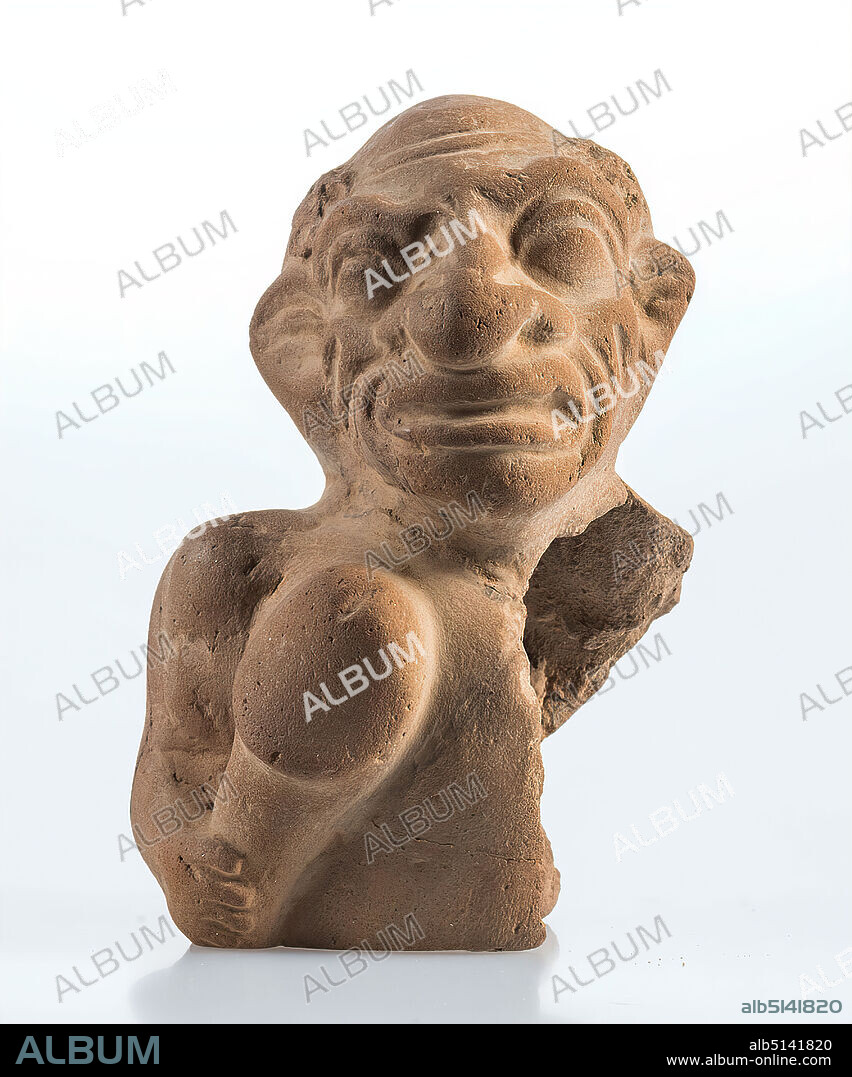alb5141820
Grotesque Man, clay, pressed into shape, hand modeled, fired (ceramic), clay, Total: Height: 10.2 cm; Width: 6.8 cm; Depth: 7.6 cm, ceramic, slavery; Slaves, penis, phallus, types of people, Hellenism, Early Imperial Period, Middle Imperial Period, The fragment of a Fayum terracotta with eyelet attached at the back shows the head and parts of the upper body of a man. It shows the typical tortured face of slaves or underclass; prominent features are the broad hooked nose, deep forehead and cheek wrinkles, thick lips and covered brow arches. The eyes are sharply contoured. A hair-wreath is indicated. A large phallus is clamped under the right arm. Lower body and the left side of the upper body are not preserved. The figure belongs to the group of the so-called Fayum terracottas. In Alexandria, the international, Greek-influenced center of Egypt, lives a multicultural society of Egyptians, Orientals, Greeks, Romans, Jews and others, whose different religious ideas are gradually blending together. Insights into this world of faith are provided by the so-called Fayum terracottas. They are part of the religious household, children's toys, knick-knacks, but also cult symbols, grave goods, pilgrimage images, votive offerings and magical objects for banishing evil forces. They can be found in houses, graves and sanctuaries.

|
Añadir a otro lightbox |
|
Añadir a otro lightbox |



¿Ya tienes cuenta? Iniciar sesión
¿No tienes cuenta? Regístrate
Compra esta imagen
Descripción:
Ver traducción automática
Grotesque Man, clay, pressed into shape, hand modeled, fired (ceramic), clay, Total: Height: 10.2 cm; Width: 6.8 cm; Depth: 7.6 cm, ceramic, slavery; Slaves, penis, phallus, types of people, Hellenism, Early Imperial Period, Middle Imperial Period, The fragment of a Fayum terracotta with eyelet attached at the back shows the head and parts of the upper body of a man. It shows the typical tortured face of slaves or underclass; prominent features are the broad hooked nose, deep forehead and cheek wrinkles, thick lips and covered brow arches. The eyes are sharply contoured. A hair-wreath is indicated. A large phallus is clamped under the right arm. Lower body and the left side of the upper body are not preserved. The figure belongs to the group of the so-called Fayum terracottas. In Alexandria, the international, Greek-influenced center of Egypt, lives a multicultural society of Egyptians, Orientals, Greeks, Romans, Jews and others, whose different religious ideas are gradually blending together. Insights into this world of faith are provided by the so-called Fayum terracottas. They are part of the religious household, children's toys, knick-knacks, but also cult symbols, grave goods, pilgrimage images, votive offerings and magical objects for banishing evil forces. They can be found in houses, graves and sanctuaries.
Personas:
Crédito:
Album / quintlox
Autorizaciones:
Modelo: No - Propiedad: No
¿Preguntas relacionadas con los derechos?
¿Preguntas relacionadas con los derechos?
Tamaño imagen:
3596 x 4320 px | 44.4 MB
Tamaño impresión:
30.4 x 36.6 cm | 12.0 x 14.4 in (300 dpi)
Palabras clave:
ADORNO • ALEJANDRIA • ALFARERIA • ARCILLA • CABEZA • CASA • CASAS • CERÁMICA • CERÁMICO • CONSERVA • CREENCIA • DECORACION • DISPARARON • EGIPCIA • EGIPCIAS • EGIPCIO • EGIPCIOS • EGIPTO • ESCLAVITUD • EXVOTOS • FE • FORMA • FRAGMENTO • GENTE • GRIEGOS • GROUP • GRUPO • GRUPO. • HOMBRE • INDICO • INTERNACIONAL • JUDIO • LADO IZQUIERDO • MUNDO • OBJETO DE CERAMICA • OJO • OJOS • ORNAMENTO • PENE • PERSONAS • PRESIONADO • PROFUNDIDAD • RELIGION • RETRATO DE HOMBRE • ROMANOS • SHAPE • TERRACOTA • TERRACOTTA • TUMBAS
 Pinterest
Pinterest Twitter
Twitter Facebook
Facebook Copiar enlace
Copiar enlace Email
Email
